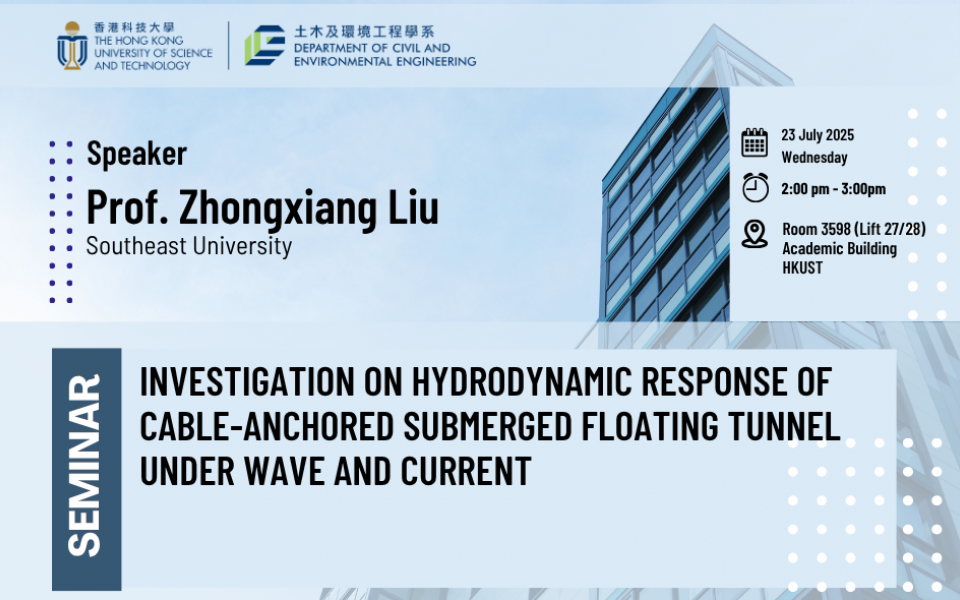Civil Engineering Departmental Seminar - Investigation on hydrodynamic response of cable-anchored submerged floating tunnel under wave and current
Supporting the below United Nations Sustainable Development Goals:支持以下聯合國可持續發展目標:支持以下联合国可持续发展目标:
Investigation on hydrodynamic response of cable-anchored submerged floating tunnel under wave and current
A cable-anchored submerged floating tunnel (SFT) is a new type of transportation structure consisting of traffic pipelines, anchoring systems, underwater foundations, etc. It is an immersed buoyancy bearing and anchoring system positioning system. The dynamic characteristics of the SFT and its hydrodynamic response in complex wave flow environments are related to service safety and stability. This study developed a new type of fully hydroelastic cable-anchored SFT test model and conducted similarity tests by combining experiments with finite element methods. A series of hydrodynamic model tests were conducted on a suspended tunnel based on an underwater vibration table, analyzing the hydrodynamic response of regular waves, extreme tsunamis, and local cable breakage, as well as the influence of wave parameters and structural parameters. At the same time, a bidirectional fluid structure coupling model and hydrodynamic performance analysis method for suspended tunnels under wave action were established, further supplementing the analysis of the influence laws of key parameters and local flow field information. The above research helps to enhance the understanding of the long-term safety and stability of suspended tunnels, and provides technical support for the design and application of suspended tunnels.
Keywords: submerged floating tunnel, model test, fluid-structure interaction, hydrodynamics
Zhongxiang Liu is an Associate Professor and doctoral supervisor at Southeast University, selected for the Jiangsu Province Youth Talent Support Project. He earned his PhD from Southeast University in 2019 and has served as a visiting scholar and postdoctoral researcher at Virginia Tech and Columbia University.
His research focuses on intelligent monitoring and performance evaluation of structures, structural hydrodynamic analysis and control, structural fatigue analysis and design theory, novel sensing, and artificial intelligence. He has led a National Key Research and Development Project (worth $1.6 million) and two projects funded by the National Natural Science Foundation of China. Liu has published over 50 SCI papers, and his research has been applied in significant projects, including damage diagnosis and structural condition assessment of the Runyang Bridge in China and the Hercílio Luz Bridge in Brazil.
He serves as a guest editor for two SCI journals and is a young editorial board member for the International Journal of Structural Integrity, the Journal of Disaster Prevention and Reduction Engineering, and Intelligent Marine Technology and Systems. Additionally, he has contributed to the compilation of three standards for the China Association for Standardization.
Liu has received several accolades, including the first prize of the Jiangsu Science and Technology Award in 2022 (7/11), the special prize of the China Highway Society Science and Technology Award (4/25), and the special gold award at the 48th Geneva Invention Exhibition (4/4)."
